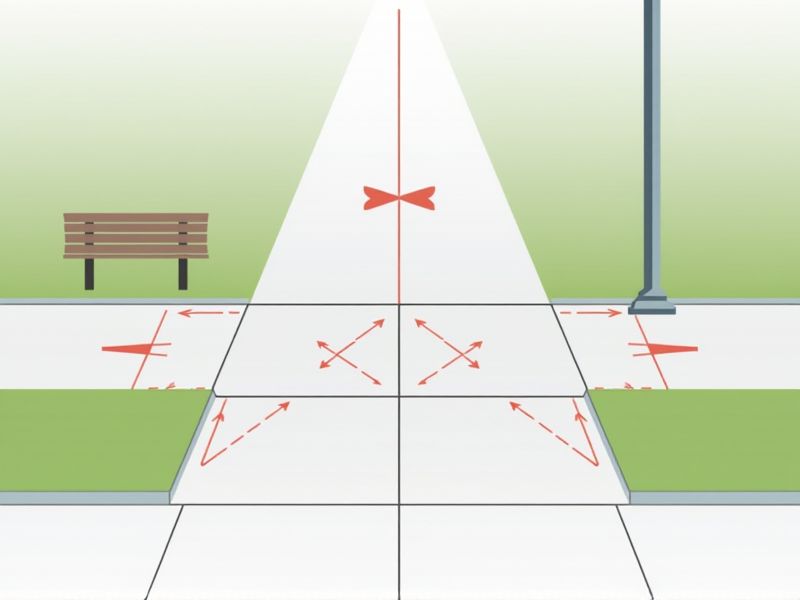
When planning or constructing a sidewalk, it's helpful to know the commonly recommended dimensions to ensure accessibility and comfort. For most residential areas, sidewalks are typically at least 4 feet wide, allowing two people to walk side by side. In busier public or commercial zones, a width of 5 to 6 feet is generally preferred to accommodate more foot traffic and accessibility requirements such as those set by the Americans with Disabilities Act (ADA). Additionally, sidewalks usually have a thickness of 4 inches for standard pedestrian use, but may be increased to 6 inches in areas where they may also support light vehicles, such as driveway crossings.
Width
The standard width for sidewalks in urban areas is typically 5 feet, allowing for accessibility and safe passage for pedestrians. In high-traffic zones, widths may increase to 6 or 8 feet to accommodate larger crowds, ensuring smooth flow and minimizing congestion. The Americans with Disabilities Act (ADA) mandates these specifications to enhance mobility for individuals with disabilities. Ensuring the correct width not only improves safety but also encourages walking as a viable transportation option.
Slope
The standard slope for sidewalks is typically 2% to 5%, ensuring effective drainage while providing accessibility for individuals with mobility challenges. This slope helps prevent water pooling, reducing potential hazards during wet conditions. Local regulations may mandate specific guidelines for slope, so it is vital to check your area's building codes. A well-designed sidewalk not only enhances safety but also promotes a smoother walking experience for pedestrians.
Cross Slope
The standard for sidewalk cross slope should not exceed a 2% gradient, ensuring optimal accessibility for individuals with mobility impairments. A properly designed cross slope facilitates effective water drainage, preventing puddling and ice formation. Compliance with the Americans with Disabilities Act (ADA) mandates that all public sidewalks adhere to these specifications to enhance safety and usability. For your project, careful consideration of the cross slope can significantly improve overall pedestrian experience and satisfaction.
Surface Texture
The surface texture of sidewalks plays a crucial role in ensuring safety and accessibility for pedestrians. Textured surfaces, such as exposed aggregate or broom-finished concrete, enhance traction, significantly reducing the risk of slips and falls, particularly in wet conditions. The Americans with Disabilities Act (ADA) recommends a surface that provides a minimum coefficient of friction of 0.6 for safe mobility. By choosing the right surface texture, you can improve overall pedestrian experience while adhering to safety regulations and community standards.
Side Clearance
The standard for sidewalk side clearance emphasizes a minimum unobstructed width of 36 inches (91 cm) to ensure accessibility for pedestrians, including those using mobility aids. Local codes may require at least a 18-inch (46 cm) clearance from curb faces or objects to mitigate hazards. It's essential to maintain this clearance near obstacles like utility poles, benches, or signs, promoting a safe and efficient pedestrian flow. You should verify your area's specific regulations to guarantee compliance and enhance the overall walking experience.
Curb Height
Curb height is a critical element in sidewalk design, typically standardized at 6 inches to provide accessibility and safety. Proper curb height prevents water accumulation on sidewalks, promoting drainage and minimizing slip hazards. For individuals using mobility aids, the height allows for smooth transitions between the street and the sidewalk. Compliance with the Americans with Disabilities Act (ADA) further emphasizes the importance of maintaining this standard to ensure all pedestrians can navigate urban environments safely.
Drainage
Effective sidewalk drainage is crucial for urban infrastructure, ensuring safety and accessibility for pedestrians. Typically, a well-designed sidewalk should have a cross slope of 2% to facilitate water runoff, minimizing puddles and reducing hazards. Proper drainage systems, such as French drains or stormwater grates, can manage up to 10 gallons of water per minute, preventing erosion and maintaining surface integrity. Ensuring these standards not only promotes longevity of the sidewalk but also enhances overall urban aesthetics and functionality.
Accessibility Ramp
Accessibility ramps are vital for ensuring that sidewalks meet the 2010 ADA Standards for Accessible Design. These ramps should have a maximum slope ratio of 1:12 and a minimum width of 36 inches to accommodate wheelchair users effectively. Proper placement at intersections and transitions from curbs to sidewalks is essential, as they create a seamless experience for individuals with mobility challenges. Regular maintenance and clear signage help ensure that these ramps remain functional and accessible for all pedestrians.
Edge Protection
Edge protection for sidewalks plays a crucial role in ensuring pedestrian safety and enhancing accessibility. Regulations often specify that a minimum edge protection height of 4 inches is required to prevent falls and delineate walking areas. Installing guardrails or raised curbs can significantly reduce accidents, providing a secure boundary between pedestrians and vehicular traffic. When planning your sidewalk, consider incorporating tactile indicators, which guide visually impaired individuals and improve overall usability.
Surface Continuity
Surface continuity of sidewalks is crucial for safety and accessibility, ensuring that transitions between different materials are smooth and level. The Americans with Disabilities Act (ADA) recommends a maximum slope of 1:12 for ramps, providing guidance for surface designs that accommodate all users, including those with mobility challenges. Proper drainage is also vital, with a standard guideline suggesting a slope of 2% away from any structures to prevent water pooling. Regular inspections and maintenance of sidewalk surfaces can enhance durability, promoting usability and increasing the lifespan of the infrastructure by reducing the need for costly repairs.
